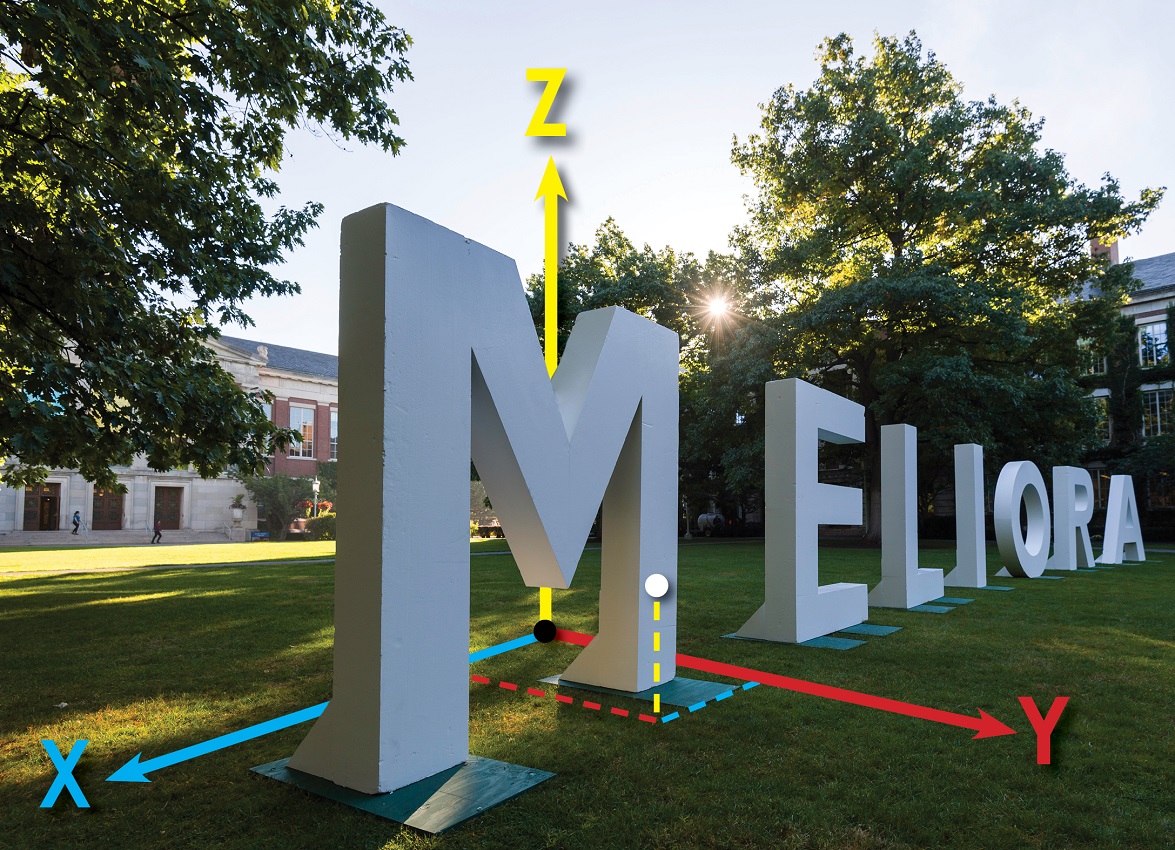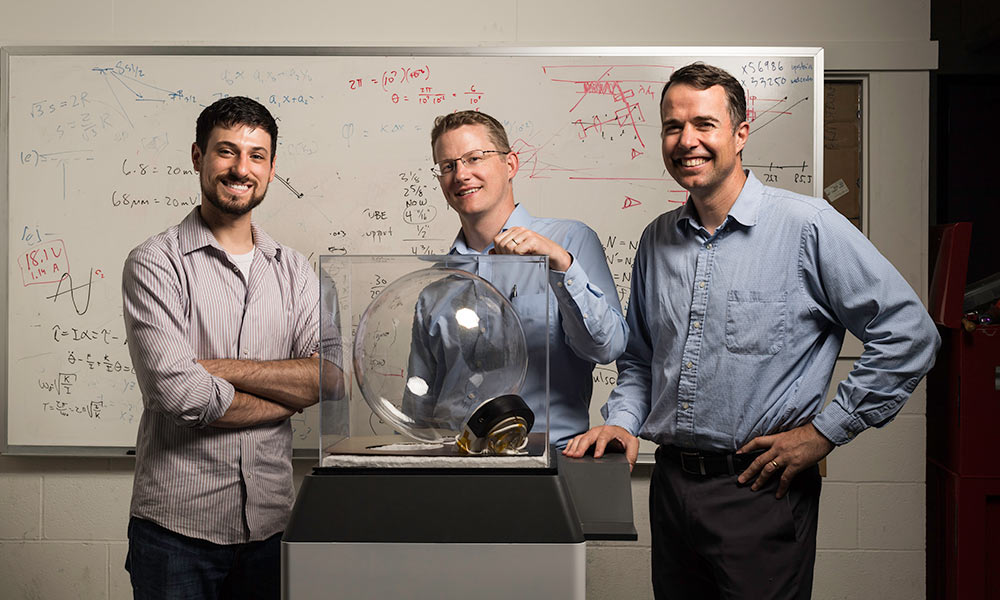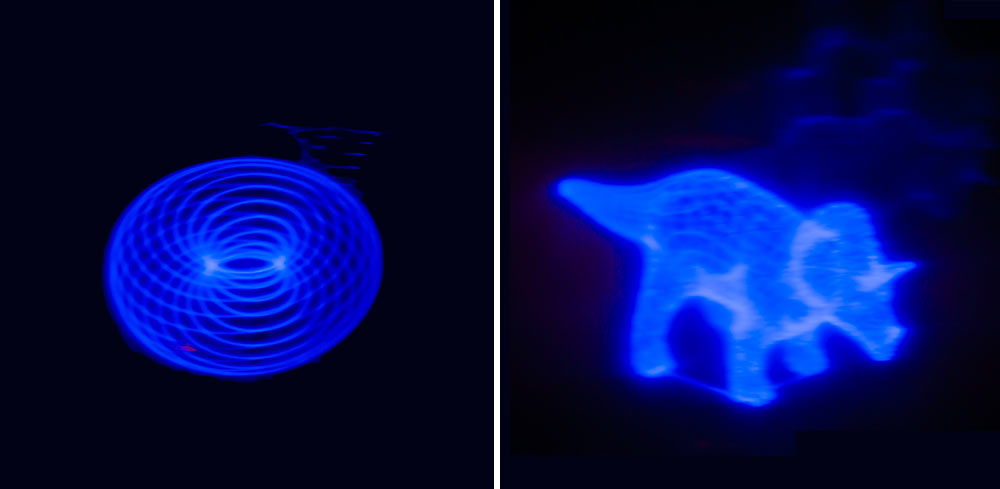June 29, 2017
In an iconic scene in Star Wars, R2-D2 delivers a three-dimensional projection of a desperate Princess Leia pleading, “Help me Obi-Wan Kenobi. You’re my only hope.”
The 3-D display that was once only a mainstay of science fiction is now closer to reality, thanks to technology developed by a team of researchers at the University of Rochester.
Their device is the next step in what is known as 3-D volumetric display, where viewers can see images in three dimensions without the use of special glasses or filters. The technology has an array of potential applications, from revolutionary surgical capabilities to new methods of communication, advertisement, and entertainment.
“As a kid I grew up reading and watching a lot of science fiction,” says Chris Mullarkey ’18 (PhD) who worked on the project with John Howell, a professor of physics and optics, and Curtis Broadbent, a research associate in the Department of Physics and Astronomy. “Getting the chance to build something that is right out of science fiction was a very cool opportunity.”
Many other approaches to 3-D displays rely on stereoscopy; that is, taking two different two-dimensional images and presenting one to either eye so the viewer perceives depth. The Rochester display, however, is a true three-dimensional representation with light created at every point in the image. The device is additionally unique in its brightness and display.
“We’ve done some engineering work to make it so you can view the images from all directions,” Broadbent says. “We’ve also been able to make them significantly brighter than what has previously been done.”
In order to give viewers a 360-degree perspective, the device consists of a glass box surrounding an airtight, glass sphere about the size of a globe that the researchers heat to approximately 70 degrees Celsius (158 degrees Fahrenheit). The sphere contains cesium vapor, a silvery-gold metal good at emitting light.
Two laser beams with wavelengths invisible to the eye are crossed in the sphere. Where the laser beams cross, cesium atoms are illuminated by both lasers and are excited into an especially high energy state. When these atoms decay, they emit sky-blue light in all directions.
“Essentially, you get this tiny, point-like source of blue photons where the lasers intersect,” Broadbent says. “That’s really the key feature that allows us to make an intrinsically 3-D object that exists in real space.”
Researchers transform blue photons into objects, such as dinosaurs or a moving helicopter, by breaking down the objects into a series of coordinates along the X, Y, and Z axes, which represent the three dimensions of length, width, and height/depth. They program the lasers to cross at these coordinates and illuminate one point at a time.

Researchers break down a shape into a series of coordinates along the X, Y, and Z axes. These axes correspond with the three dimensions of length, width, and height/depth. (University illustration / Sarah Kirchoff)
“The image never really exists at one time, even though we perceive it that way,” Broadbent says. “If you want a sequence of points to look like an image, you need to draw it fast enough so the eye can’t tell that the image is being drawn point by point.”
The lasers illuminate each point for a fraction of a second and are able to light up all of the points that make up the image in about 50 milliseconds (one millisecond equals one thousandth of a second).
Before high definition technology, early televisions employed a similar two-dimensional version of this phenomenon using vector scanning. An electron gun within the television would send a stream of electrons onto a fluorescent screen, illuminating one point at a time. The electrons would then be scanned over the lines in the image. Researchers essentially apply a 3-D version of this technique in the 3-D volumetric display.
The basic idea for three-dimensional images formed using crossed lasers in metal vapors started in the 1960s and picked up traction in the late 1980s, although the images were not very bright, nor very large. Since then, researchers have attempted various setups and methods, which often proved impractical due to cost and weight of materials. The Rochester approach uses metal vapors and patent-pending techniques to boost the brightness and size of the display. In their latest prototype, the images are drawn in a one-foot diameter sphere and are viewable from all directions.

Curtis Broadbent [center], a University of Rochester research associate in physics and optics professor John Howell’s [right] group, along with Chris Mullarkey ’18 (PhD) [left] pose with their system for creating 3-D volumetric images. (University photo / J. Adam Fenster)
“There were many times where we thought it wasn’t going to work,” Howell says. “And there are still strategies to improve upon it—making it brighter with additional lasers, for instance.”
While still in its early stages, the technology has potential functions including applications in air traffic control; advertising; projecting 3-D versions of people and events for video conferencing and general communication or entertainment purposes—if there were a controversial call in a sporting event, you could observe what happened from all angles; or displaying scans of the heart or brain in 3-D.
“Depth is a real problem for surgeons doing very small vascular repair work,” Broadbent says. “A mounted display that would show depth and highlight different tissue structures would allow surgeons to peer around the sterile field as they manipulate surgical instruments, without having to wear heavy magnifying glasses.”
The team has filed patent applications and hopes to license the technology for commercial use.
That means that transmitting messages in 3-D such as R2-D2’s message to Obi-Wan may be closer than we think.















